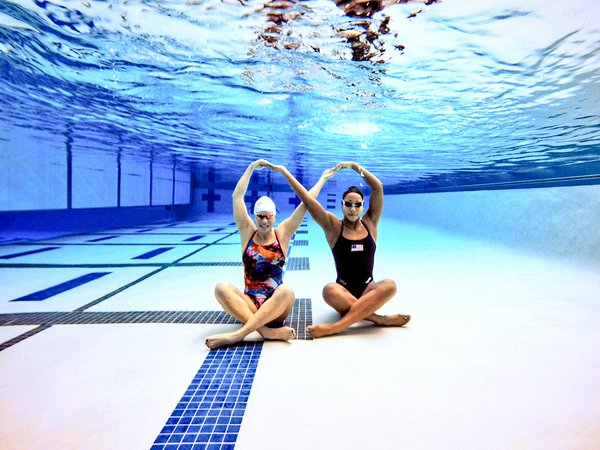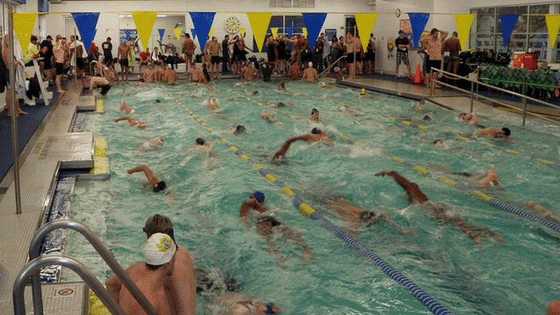
Pool Clarity Matters
I was a competitive swimmer for many years. I cannot tell you how many times I have been asked questions along the lines of "what do swimmers value in a pool?" or "what makes a fast pool?". The appearance and feel of a pool is an emotional factor for people, but from our standpoint in the aquatics industry, water clarity is also a legitimate issue to address. Pool clarity is an obvious metric in which facility operators–and indeed, a facility itself–can be judged on. To swimmers, however, clean water is inviting.

Nobody wants to dive into a cloudy, dirty pool. Grease and oils on the top of the water are gross too. Whether the pool is an indoor competition pool or an outdoor recreation pool, if we see a nasty pool, it is human nature to want to avoid it. But competitive swimmers seldom have the luxury of that choice. When we are told to get in, we get in.
I remember flying out to a swim meet (which shall remain unnamed) and having to swim in the warm-up/warm-down pool for 4 straight days of competition. The first day, the water was decent. The second day it was cloudy and loaded with oily sunscreen that you could see on the surface. It reflected the sunlight and it looked like a cesspool. By the third day, it was so cloudy I could not see the tile line underneath me, and the water physically felt disgusting. It was sticky...slimy...oily...and just gross. The pool's system, operations and chemistry could not keep up with the bather load.
I chose not to even get in it the fourth day, which basically forfeited my race...but I didn't even care.
As an aside, I just did an image search for the pool, and to be expected, they only show it without swimmers and clean...there are no photos of it loaded with swimmers, and for good reason. I am certain the venue does not want photos of what the pool really looks like when being used. And this facility is very high profile too. If cloudy water is a huge problem for them, imagine what it is for pools without the big budget for fancier filters and controllers...
So what makes a fast pool? How about a pool that fast swimmers want to be in. A pool that looks and feels clean is a great start.
Cloudy water is a symptom of bigger problems
Water clarity is one of the most obvious signs of a well-run pool. When water is cloudy, everyone knows it's not good. And yet, cloudy pool water is so common, people have just grown to accept it. We think of cloudy water being the problem itself, but in reality, cloudy water is just a symptom of larger problems. Problems with filtration, perhaps. Or maybe it's a sign that the chlorine is overwhelmed, which can actually be dangerous.
Clear Water ≠ Clean Water
It is important to make the distinction between clean water and clear water. While it is ideal to have both, it is very possible to have one without the other. Clean water (i.e. healthy water) is characterized by effective disinfection and sanitization, and usually a high Oxidation Reduction Potential (ORP). Clean water is balanced water, with a residual of free available chlorine, low combined chlorine (if any), and no visible bather waste (like oils on the surface or scum lines).
Related: Organic Waste and Carbon Management (Pillar 2)
Clear water, however, is not necessarily the same as healthy or clean...it just looks clean. Clarity is the opposite of turbidity, which is just a fancy word for cloudiness. And it is definitely possible to have clear water that is woefully out of balance and aggressive. Aggressive, low-LSI water looks amazing. The lower the pH, the stronger the chlorine (because the % of HOCl is higher), and water looks cleaner. So sure, the water will look fantastic and clear, but at the cost of acidic water that can cause eye and skin irritation, as well as permanent damage to the pool and its equipment. We at Orenda see it all the time.
Oh, and another thing while I'm thinking about it. Just because water looks good from the outside does not mean it is clear on the inside. I know this from personal experience. You can walk by a pool and see straight to the bottom, clearly see the tile line, even in the deep end. Then you get in and can't see 20 feet through the water. Today was a perfect example. I was swimming at my local YMCA's outdoor pool, and it looked decent before I got in. Then I got in and could hardly see anything it was so cloudy. Looks can be deceiving. I just felt the need to share that, because to my surprise, most pool professionals hardly ever (if ever) get in the water with goggles on and experience the water for themselves.
Formula for world class water clarity
- Effective Filtration and Circulation
- Organic Waste and Carbon Management
- Optimal Sanitizer Performance and Efficiency
Effective Filtration and Circulation
Pools mostly use cartridge, sand or DE filtration. Regardless of which type is on your pool, effective filtration occurs when your filter has a good flow rate and pressure. One obvious enemy of filters is organic [bather] waste. Organic waste tends to be sticky and oily, which creates a 'slimy gunk' (that's a scientific term). Slimy gunk attracts more particulates and gets gunkier and slimier. Some of this gunk and slime can invite the formation of biofilms, which are highly chlorine resistant and can harbor diseases. Furthermore, when slimy gunk spreads throughout the filter media, it can clump it together and make filtration less effective. This can lead to problems like filter channeling, over-pressure damage like crushed DE grids, or just plain disgusting filters.
Conventional wisdom in the pool industry agrees that the vast majority of disease and bacteria lives in the filter itself...not the pool. That means even when clean water passes through the dirty, gunky filter, it's touching the worst stuff in the system. Not good.
In terms of comparing each filter type, that's a matter of opinion, and we have no dog in that fight. One thing is certain, however: regenerative DE filters are the most expensive, and have [by far] the most screening capability. They can filter particles as small as 1 Micron (µ). Most pools do not need 1µ of filtration, but it certainly improves water clarity.

Organic Waste and Carbon Management
Organic waste is introduced to the water by bathers or outside factors. This means that organic waste not only gets stuck in the filter, it also lurks in the pool itself...and it usually floats. These non-living organics are hard to get rid of, because chlorine is gets reduced rapidly when oxidizing them. Sure, chlorine will oxidize it as well as it can, but organic waste is complex, when chlorine is designed to kill simple organisms (like bacteria). It takes a lot more chlorine to oxidize organic waste than to sanitize bacteria.
Related: Sanitization, Disinfection and Oxidation
Non-living organics are pretty much inevitable, especially in commercial pools. And relying solely on chlorine to handle them is inefficient, costly and may not even get the job done. Remember, chlorine is not designed to control organics. Adding more of it doesn't change that.
Optimal Sanitizer Performance and Efficiency
Of the chemistry-related issues that lead to cloudy water, having an efficient sanitizer can answer many of the problems. No, chlorine is still not designed for organic waste, but it is the best line of defense against reproducing microorganisms like algae1. High performing chlorine can also oxidize through Nitrogen compounds like urea and Ammonia faster than if it's being reduced on other oxidants. The concept is simple: free up chlorine so it can handle what it needs to. Help chlorine delegate its responsibilities where possible.
Keeping pH in a good range to maintain LSI balance, yet low enough for optimal chlorine strength (↑ % HOCl) is a good start. You can also remove phosphates, which fuel the growth of contaminants. While removing phosphates will not kill anything, it gives chlorine a better chance of staying ahead of algae.
Then, of course, there are secondary sanitizer and oxidizer systems. These are like UV, Ozone, AOP and HDO. UV, Ozone and AOP are actual sanitizers and disinfectant systems that kill germs and living things like algae. AOP and Ozone are strong oxidizers, as is HDO, albeit much weaker. The advantage HDO has over the others is that it leaves a residual in the water that can boost chlorine efficacy everywhere in the pool, not just in the pump room. UV, Ozone and AOP are all point-of-contact systems, and that is their limitation.
My Case for Enzymes
Long before I worked for Orenda, I experienced their CV-600 enzymes as a swimmer. The first time was at a pool in Charlotte NC; a big 50-meter pool I had trained in for over a year. I had never seen 50 meters across it underwater, because it was always cloudy. After taking an 18 month hiatus from the sport, I went back for a swim one afternoon, and dove in.
It freaked me out. Here's a video interview I participated in years before I worked for Orenda. This was my honest testimony of my experience, with video showing you the clarity of the pool.
The water felt weird...it felt different...it felt...good. Silky, almost. I looked up and the clarity shocked me. I turned left and looked across the entire pool and saw 50 meters across like I was in drinking water. I could not believe it. I asked the coach what they put in the pool, and they told me it was "some enzyme". That was my first experience with Orenda Enzymes, and it would not be my last.
Months later I was competing to try and qualify for the 2016 Olympic Trials. The warm-up pool at this meet was notoriously overloaded (see the photo below, from the year prior to this story). And yet this time, the warm up pool was looking really good, and I felt the same silky water. The competition pool actually became cloudier than the warm up pool that meet, which was astounding. Come to find out, the warm up pool was treated with Orenda enzymes, and the competition pool was not.
At that point I had no more questions. If these enzymes could handle THAT, they could handle any bather load.
Want help achieving world class water clarity? Orenda enzymes can do much of the heavy lifting. It is an all-natural formula that can break down and digest carbon waste (all organic waste has carbon in it). Once digested, the byproducts are carbon dioxide, inert molecules, and water. That means the non-living organic waste that enzymes touch will cease to interfere in a short amount of time.
With less organic waste (which could mean less chlorine demand), enzymes can make an operator's job easier, and allow for world class water clarity. I know that from personal experience.
1 Orenda does not make any product that kills or prevents growth of any living contaminants. Only a sanitizer like chlorine, or an EPA-Registered product can kill or prevent growth.

